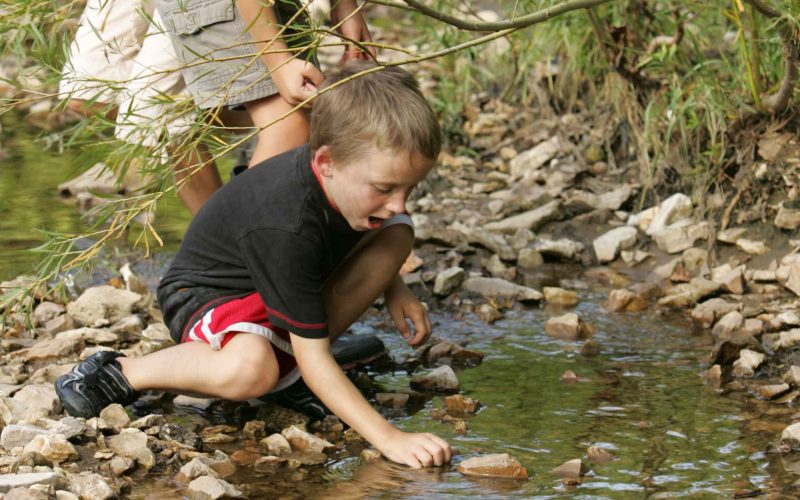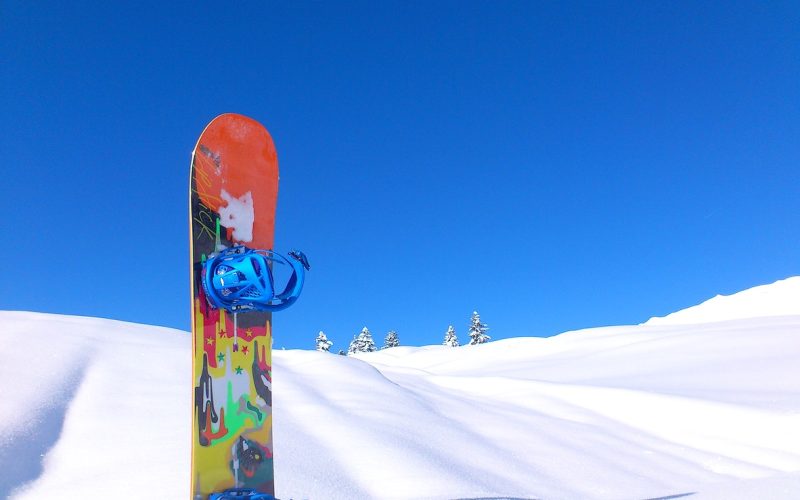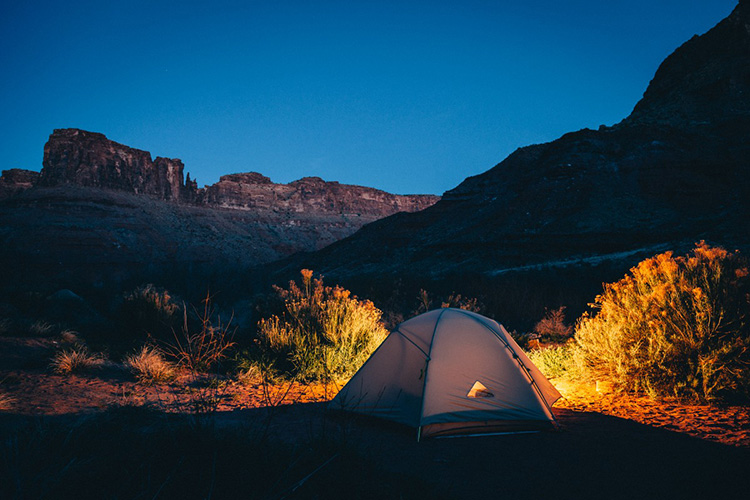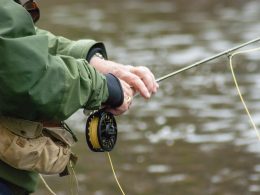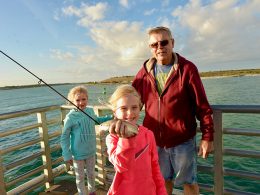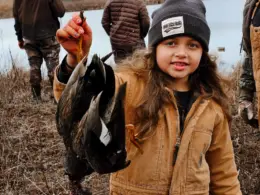Kids in the outdoors never seemed like a topic needing attention. Most of us hear “kids in the outdoors” and are met with vivid memories of our childhood recesses and riding bikes in the cul-de-sac. Or if you were a country kid, like me, playing in the pasture and summer nights catching lightening bugs. Yet, the reality is today “free time” looks like a child on an electric device disconnected from nature. Am I saying technology is bad? No, I am just pointing out the imbalance.
So, how does this playing into the outdoor community? It is no secret that the number of American hunters and anglers is on the decline. Based on recorded hunting license sales in 2020, hunters make up only 4.6 percent of the population. Compared to the data provided by the U.S. Fish and Wildlife Service, in 1960, the percentage was 7.7 percent of the population. Though we have seen growth within the hunting community the population of the United States has also grown. In turn, reducing the percentage of hunters and anglers overall. There has been increased efforts to recruit more hunter and anglers.

Wildlife Agencies and Conservation Organizations depend on proceeds for grants and funding excise tax provide. All of which depend on the number of hunters and anglers purchasing firearms, licenses and other recreational equipment. Here is where kids come in, they are a crucial piece in continuing this way of life. They are the future! Who is going to be the public land and conservation advocates in the future?
Table of Contents
Get Outside!
The first step is to get outside, explore and learn! Thankfully generations before us have secured access to public lands and wildlife refuges’. Many states have done an excellent job managing these lands and they are great places to take the kids. Exposing kids to the outdoors with hiking, fishing, walks around a pond, shooting sports, or a camping trip are fun ways to introduce them to outside activities. Make it fun with no pressure. Sparking their love for the outdoors is key.
Think of why you love it? Is it the fresh air, the solitude or the reconnection to something primal? Most of us in America have lost the connection to our food. Many haven’t seen an animal butchered or picked fresh tomatoes out of a garden. The outdoors is a lifestyle not a one trip mission. We have to recognize the fact that the time we put in early in a kids life will turn in a hunter, fisher, or trapper for the next 30 plus years. Keep the expectations low!
Time lines will change, they will be loud, and most likely they will get bored. Bored is good! It allows them time to practice patience, maybe notice something they did not before. In this day in age, where we are constantly stimulated and the next entertaining number is the next swipe. I think we can all agree we all could use “unplugged” bored moments. There is something about natures that regrounds you. It allows you to disconnect from society.
Become Mini Biologist and Conservation Activist
A big misconception about hunters is that we just go out and kill stuff. It is so much more than that. We are self-taught biologist and participating conservationist. Hunters study the habitat and patterns of the animal they are hunting. They learn behaviors and watch the populations. For example, many whitetail hunters manage their local herds by fostering genetics, allowing bucks to mature and regulate the doe ratio. Hunters become first hand witnesses the animal and its behaviors.
Begin by teaching kids how to find signs animals leave in nature. For example, whitetail scrapes, rubs, dropping and tracks. Take the kids scouting during the golden hour. Make it a game on how many animals you can spot. Perfect time to go over identifying animals, picking out gender traits and differentiating between species. Teach them where to look by finding bedding sights, a water hole or their food source. Show them how to bank fish, locate fish habitats and how to choose the best lures.

Promote curiosity, allow them to ask questions and develop an understanding. Fostering a love for the land and respect for its resources will reinforce the values of conservation. I personally have used the history of the American bison and wild turkey to show the importance of conservation. It is imperative we learn from the past. The wildlife habitat has shrunk due to human population and infrastructure expansion. Hunters play a vital piece in managing wildlife populations.
Explain if hunters do not harvest animals, too many will be left to compete for the same resources. In turn, creating overpopulation of a species in one area and depleting its resources. Predator hunts are a prime example of keeping the balance. Predators like raccoons, foxes, and coyotes can wreak havoc on turkey, upland bird and waterfowl nest. The creation of beaver dams disrupt water diversity and fish migration.
Teach the Basics
The number one entry into the outdoor lifestyle and hunting is through mentorship. If you ask most outdoorsmen and women today who got them into the outdoors many will be able to name an influential person and the impact they left on them. Many conservation organizations and wildlife agencies have caught on to this an introduced hunting heritage programs and special youth hunt days, as an incentive to get children involve.
Kids need prepared, they are not going to know how to pretty much anything. I personally think kids are resilient and pick up on thing fairly easily. The goal here is get them to enjoy their experiences with explanation that Mother Nature accommodates no one. So we have to prepare for the season we will face with adequate gear and attire. Today it is easier to get kids using weapons. Crossbows are a great way to get kids into archery. Many rifle companies have manufacture youth rifles at affordable cost.

Organizations like 4H offer projects like shooting sports and archery that instruct on proper firearm and bow usage. The 4H clubs provide the weapons and ammo. The shotgun course would be a perfect way to get a kids into upland hunting putting their learned skills to use. Do not just stop with the hunt or fishing experience. Let them help with the harvest, butchering, preserving, and cooking are all much needed life skills. As a homeschool mom I find this is always a fun away to have a short anatomy lesson. This also allows them to taste the fruits of their labor.
Hunting and fishing are sports that require a lot of dedication. If you have been fishing or hunting for any amount of time you know there will be days when you get “skunked” and see nothing. Those days will happen with kids I tow too. It is always a good idea to make a big deal and involve them as much as possible when a harvest does occur. However, when it does not, you can still make a lesson out of it. There is always a take away for a day on the water or sit in the woods.
The End Goal
It is crucial we keep the sport of hunting alive. We as outdoorsmen and women want the kids to love the sport as much as us; but, we cannot force them. The end goal is to foster a love for the outdoors, teach the kids to protect its resources and how to use their skills to provide meals for themselves.
The outdoor lifestyle is more than a sport it is a series of life lessons and traditions being passed on. The hunting heritage was not developed by one hunter, trapper, or angler. It was generations of passing down skills and different methods. It is finding a place where you thrive in the outdoors and sharing that. We are continually building life skills, self-reliance, and learning to respect nature. Most outdoor enthusiast say nature is their escape.

A place where they go to unplug and retreat from the taxes of life. It is where they learn the most about themselves. Nature is where they learned and practiced patience and self-control. How they developed diligence and discipline. Why would we not offer that to our children too? They are just as much in need of an “unplugging.”
According to the Child Mind Institute, the average child spends 4 to 7 minutes of unstructured play time outside a day and over 7 hours on a screen. Yes, 7 hours, yikes! Researchers agree that kids need more outdoor play. It is crucial to their development and creates a happier, healthier and less anxious child. It is time we take back our youth and gift them the outdoor experience. Pouring into their lives now will pay off in the future. Our public lands and wildlife populations depend on it! Our children’s mental states’ and continued outdoor traditions hang in the balance.

